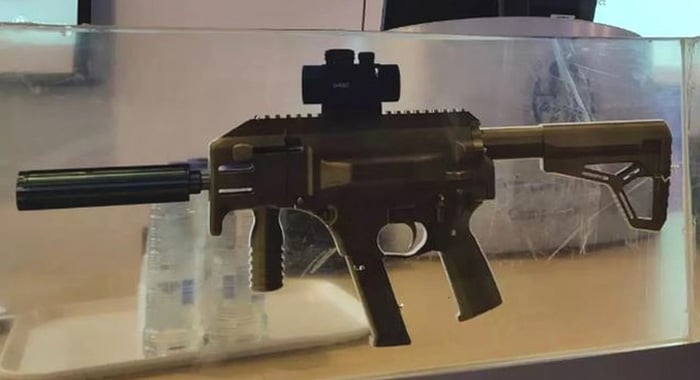The global arms race is no longer limited to nations or organised armies it is being quietly revolutionised in garages, bedrooms, and basements, thanks to affordable 3D-printing technology. The implications are profound, especially as signs emerge that Islamist militants, long wedded to traditional modes of violence, are now turning their attention to 3D-printed firearms (3DPFs). For years, groups like the Islamic State (IS) prioritized knives, vehicles, explosives, and AK-47s. But the emergence of digital weaponry on jihadist platforms indicates a dangerous technological evolution, one that could soon bypass global arms controls altogether.
The latest red flag came in August 2024, when a pro-IS account disseminated a detailed manual for printing the “Urutau” a semi-automatic 9mm rifle on a prominent jihadist messaging platform. Entirely do-it-yourself and free of regulated parts, the Urutau draws inspiration from the FGC-9, a hybrid 3DPF originally designed to skirt stringent European gun laws. The manual wasn’t shared in isolation; it was accompanied by guides on crafting homemade ammunition and barrels. Predictably, pro-IS sympathisers responded with enthusiasm, suggesting that these designs are being studied, if not already replicated.
This is not the first time jihadist forums have discussed 3DPFs. But the renewed intensity and specificity of current conversations hint at a growing operational interest one that directly threatens societies where conventional arms are tightly regulated. In such countries, 3DPFs could be a game changer. They enable lone actors or clandestine cells to bypass black market networks and manufacture lethal weapons undetected. The technological barrier is falling fast. For less than $300, a 3D printer and a handful of materials from a hardware store are all that’s required to create a functional, deadly weapon.
Although Islamist militants have been relatively slow adopters of 3D printing, recent cases suggest that this is changing. In January 2023, British authorities charged Abdiwahid Abdulkadir Mohamed with possession of 3DPF instruction manuals believed to be intended for use in a terrorist act. Then, in September 2023, Mohammad al-Bared, a PhD student from Coventry, was accused of designing a 3D-printed drone for IS. Meanwhile, in Somalia, the jihadist group al-Shabaab has reportedly been experimenting with 3D printing to fabricate explosives, drone components, and other battlefield tools—making it one of the first Islamist groups to systematically explore the technology.
These developments, though dispersed, form a clear pattern: Islamist actors are increasingly willing to experiment with emerging technologies that were previously dominated by far-right extremists. In fact, the far-right has already demonstrated how dangerous this path can be. The 2019 Halle synagogue shooter used 3D-printed components in his failed attempt to carry out a massacre. Since then, interest in 3DPFs has surged across extremist ecosystems, particularly in Europe, North America, and Australia.
So why are 3DPFs so appealing to terrorists?
First, they provide an effective workaround in regions with tight firearms regulations. Models like the FGC-9 and Urutau are engineered to function without any regulated gun parts. They rely instead on 3D-printed components and commonly available materials springs, screws, and steel tubing that arouse little suspicion when purchased. The FGC-9, notably, was specifically designed to help individuals in Europe evade gun control regimes. It has since been linked to several thwarted attacks by jihadist and far-right cells in the UK and Finland. The weapon has also appeared on the front lines of Myanmar, where pro-democracy forces have used it in combat, marking the first known instance of a 3DPF deployed in an active conflict zone.
Second, 3DPFs offer an unparalleled level of anonymity and operational security. Unlike smuggling arms or engaging with illicit dealers activities that can be monitored and intercepted printing a firearm at home requires no third party interaction. This eliminates many of the traditional intelligence touch points and makes detection significantly harder. Add to this the growing body of online literature on homemade ammunition, and the path to full weapons independence becomes clearer.
Moreover, the innovation doesn’t end with guns. 3D printing is now being used to produce firearm silencers, automatic conversion devices, and even blades and explosives. Some designs are disguised to resemble harmless objects like Nerf toys posing a significant challenge for law enforcement. A 3D printer and some technical know-how are all that separate intent from action.
To date, the chatter around 3DPFs in jihadist circles remains more aspirational than operational. But the pattern is undeniable, and the pace is quickening. Every day, new blueprints are uploaded, modified, and disseminated online. The barrier to entry has never been lower, and the threat has never been so diffuse.
The global security community must not wait for a mass-casualty event to take this seriously. Preventative steps should include enhanced digital monitoring of extremist forums, legal frameworks to criminalise possession of 3DPF components and instructions, and international cooperation on the regulation of 3D-printing technologies. These tools must evolve in tandem with the threat they’re meant to counter.
It took only one failed attempt in Halle for the far-right to embrace the 3DPF revolution. It will take only one successful attack by a jihadist actor for the same trend to take root in Islamist extremist circles.
The question we must ask is not whether this future is coming it is already here. The only question that remains is whether we are prepared.





